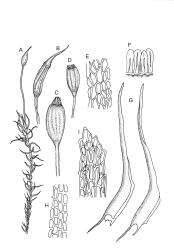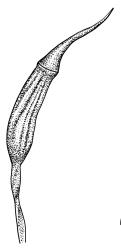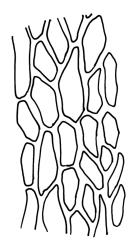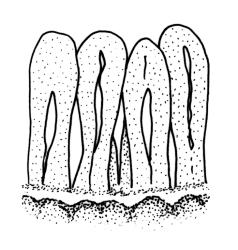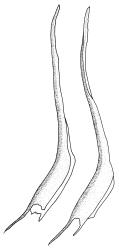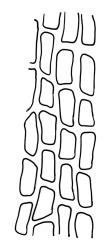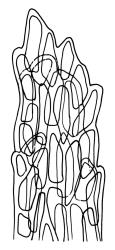- ≡ Aongstroemia dietrichiae Müll.Hal., Linnaea 35: 617 (1868)
Dicranella tricruris sensu Sainsbury (1955, p. 108)
Plants rather small, yellow-green, forming thin or dense turves. Stems c. 7–15 mm, in cross-section with a weak central strand and 3–4 layers of thick-walled cortical cells. Leaves wide-spreading from an erect and sheathing base, contorted when dry, abruptly tapered from an oblong base to a ± subulate and spreading limb, with well defined shoulders, acute or rounded at apex, entire below, at apex crenulate on all surfaces due to projecting cells, mostly c. 2.0–2.5 mm long immediately below perichaetium, and reduced to c. 1 mm on lower stem, broadly U-shaped in cross-section, plane at margins or ± reflexed at shoulders; cells of mid limb short-rectangular, obscure, c. 6 µm wide and 2–4:1, firm-walled, unistratose, smooth but becoming bulging at upper end of cells near apex; cells of leaf base oblong-rectangular, mostly 15–45 × 6–9 µm, smooth, becoming shorter and ± quadrate at shoulders. Costa occupying ⅕–¼ of the leaf base, well-defined, percurrent, not filling the limb, in cross-section (at mid limb) with median guide cells and abaxial and adaxial stereid groups; the cells on the adaxial surface more elongate than adjacent laminal cells. Tubers apparently absent.
Dioicous. Perichaetia with leaves to c. 4 mm but otherwise not differentiated. Perigonia not seen. Setae 5–10 mm, straight or slightly flexuose, dextrorse, pale brown or yellow; capsules erect, ovate-cylindric, narrowed below the mouth when dry, c. 1–1.2 mm, not strumose, sulcate when dry; mouth transverse; exothecial cells irregular, not in distinct columns, uniformly thick-walled; stomata apparently absent; annulus differentiated, falling with the operculum or with fragments persisting; operculum slenderly rostrate, c. 1 mm. Peristome teeth c. 325 × 50–60 µm, divided c. ½ to base into two ± equal forks (but some teeth undivided or unequally divided), strongly striolate-papillose in lower half, with coarse trabeculae on outer surface. Calyptra as per genus. Spores 21–27 µm, yellow-brown, densely insulate, with individual insula c. 1.5–2.5 µm diam.
In Dicranella only D. vaginata and D. cardotii share the features of sheathing leaf bases and distinctly shouldered leaves. However, both these taxa have non-sulcate capsules with poorly differentiated annuli and normally occupy streamside habitats. The N.Z. range of D. dietrichiae overlaps considerably with that of D. vaginata, but the latter species has very distinctive robust and rigid subulae (limbs) completely filled by the costae. There is little range overlap between the northern and lowland D. dietrichiae and the more southern and higher-elevation D. cardotii.
Recognition of sterile material sometimes poses difficulties. Sterile material is sometimes confused with D. schreberiana, but D. dietrichiae has more distinctly sheathing and more-shouldered vegetative leaves. Occasional specimens, however, cannot be placed with confidence.
Confusion sometimes occurs with Campylopodium capillaceum, but that species has longer vegetative leaves (mostly 3–6.5 mm on upper stems), much stouter, more flexuose setae, and conspicuous phaneropore stomata.
Sterile material of D. dietrichiae could also easily be confused with Trichodon cylindricus, q.v. It is best separated from this species by being a larger plant with smooth laminal and costal cells (vs prorate cells in T. cylindricus). Their documented N.Z. ranges do not overlap.
NI: N Auckland (West Russell State Forest, near Whakapara on road to Helena Bay), S Auckland (Whale I., Rotorua, Waimangu Valley, Ōrākei-kōrako).
Australasian. Mainland Australia* (Qld, N.S.W.). Reported from Tasmania by Dalton et al. (1991).
This poorly documented species favours finely textured (clayey) soil. The initial N.Z. collection (K.W. Allison 631, CHR 532232) came from thermally heated soil at Ōrākei-kōrako on the Waikato River, as did material from Rotorua and sterile material from Whale I. It also occurs sometimes on non-heated clay in open pasture (A.J. Fife 5812, CHR 104142). Associates can include Campylopus pallidus, Entosthodon radians, and Philonotis tenuis. All confirmed records are from relatively low elevations, but precise elevation data are lacking. Scott & Stone (1976) describe it as a "common species in the coastal forest of N.S.W., where it is a soil-binder on the fresh crumbly clay-loams".
The erect, sulcate capsules with well-differentiated annuli, and gametophores with wide-spreading leaves with sheathing bases, distinguish D. dietrichiae from its N.Z. congeners. The slenderly rostrate operculum is very unusual in Dicranella. Its preference for geothermally heated soil also facilitates its recognition here, but not in Australia.




